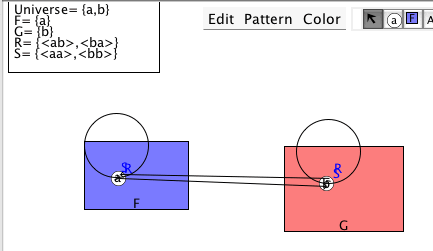
The semantics of relations proceeds in much the way one would expect-- the new item that has to be taken account of is the order of the terms (because, for example, Tab is not at all the same thing as Tba -- Arthur being taller than Beryl is not the same as Beryl being taller than Arthur).
Let us start with an Interpretation
Interpretation 1
Universe= {a,b}
F={a}
Remember, there needs to be an account of how the various symbols in the predicate logic formulas apply in this Universe. There are the constant terms a,b,c... -- at an introductory level we can just let a name a, b name b etc. There are the predicates -- here we just have to say which members of the Universe a predicate applies to, and this can be done by writing, for example, F={a} to mean that a has the property F; many properties will not apply to any of the objects in the Universe, if, for example, G applies to nothing, this could be written G={} or nothing need be written at all.
There are also now the relations -- here we just have to say which members of the Universe a relations applies to, and this can be done by writing, for example, R={<ab>} to mean that a bears the relation R to b (in that order); many relations will not apply to any of the objects in the Universe, if, for example, S applies to nothing, this could be written S={} or nothing need be written at all.
Now consider
Interpretation 2
Universe= {a,b}
F={a}
R={<ab>}
The formula Rab is true under Interpretation 2. The formula Rba is false under Interpretation 2. The formula Sab is false under Interpretation 2. The formula Rab∧Fa is true under Interpretation 2. The formula (∃x)Rax is true under Interpretation 2. And so on...
The Interpretation in Predex13 shows an Interpretation similar to this

if it does not, draw a similar one yourself.
Exercise 1(of 1)
Interpretations Applet